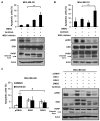Varlitinib Downregulates HER/ERK Signaling and Induces Apoptosis in Triple Negative Breast Cancer Cells
- PMID: 30658422
- PMCID: PMC6356324
- DOI: 10.3390/cancers11010105
Varlitinib Downregulates HER/ERK Signaling and Induces Apoptosis in Triple Negative Breast Cancer Cells
Abstract
Triple-negative breast cancer (TNBC) is a complex disease associated with the aggressive phenotype and poor prognosis. TNBC harbors heterogeneous molecular subtypes with no approved specific targeted therapy. It has been reported that HER receptors are overexpressed in breast cancer including TNBC. In this study, we evaluated the efficacy of varlitinib, a reversible small molecule pan-HER inhibitor in TNBC. Our results showed that varlitinib reduced cell viability and induced cell apoptosis in most TNBC cell lines but not in MDA-MB-231 cells. MEK and ERK inhibition overcame resistance to varlitinib in MDA-MB-231 cells. Varlitinib inhibited HER signaling which led to inhibition of migration, invasion and mammosphere formation of TNBC cells as well as significant suppression of tumor growth of MDA-MB-468 xenograft mouse model. In summary, these results suggest that HER signaling plays an important role in TNBC progression and that pan-HER inhibition is potentially an effective treatment for TNBC patients.
Keywords: pan-HER inhibitor; triple-negative breast cancer.
Conflict of interest statement
The authors declare no potential conflict of interest.
Figures





Similar articles
-
GPER mediates enhanced cell viability and motility via non-genomic signaling induced by 17β-estradiol in triple-negative breast cancer cells.J Steroid Biochem Mol Biol. 2014 Sep;143:392-403. doi: 10.1016/j.jsbmb.2014.05.003. Epub 2014 May 27. J Steroid Biochem Mol Biol. 2014. PMID: 24874276
-
Design, synthesis, and validation of novel nitrogen-based chalcone analogs against triple negative breast cancer.Eur J Med Chem. 2020 Feb 1;187:111954. doi: 10.1016/j.ejmech.2019.111954. Epub 2019 Dec 7. Eur J Med Chem. 2020. PMID: 31838326
-
Thymoquinone inhibits cell proliferation, migration, and invasion by regulating the elongation factor 2 kinase (eEF-2K) signaling axis in triple-negative breast cancer.Breast Cancer Res Treat. 2018 Oct;171(3):593-605. doi: 10.1007/s10549-018-4847-2. Epub 2018 Jul 3. Breast Cancer Res Treat. 2018. PMID: 29971628
-
EGFR and MEK Blockade in Triple Negative Breast Cancer Cells.J Cell Biochem. 2015 Dec;116(12):2778-85. doi: 10.1002/jcb.25220. J Cell Biochem. 2015. PMID: 25959272
-
Novel therapeutic strategies for patients with triple-negative breast cancer.Onco Targets Ther. 2016 Oct 21;9:6519-6528. doi: 10.2147/OTT.S105716. eCollection 2016. Onco Targets Ther. 2016. PMID: 27799799 Free PMC article. Review.
Cited by
-
Significance of Kynurenine 3-Monooxygenase Expression in Colorectal Cancer.Front Oncol. 2021 Apr 16;11:620361. doi: 10.3389/fonc.2021.620361. eCollection 2021. Front Oncol. 2021. PMID: 33937026 Free PMC article.
-
Differential Protein Expression in Response to Varlitinib Treatment in Oral Cancer Cell Line: an In Vitro Therapeutic Approach.Appl Biochem Biotechnol. 2024 Apr;196(4):2110-2121. doi: 10.1007/s12010-023-04642-3. Epub 2023 Jul 20. Appl Biochem Biotechnol. 2024. PMID: 37470935
-
Inhibiting EGFR/HER-2 ameliorates neuroinflammatory responses and the early stage of tau pathology through DYRK1A.Front Immunol. 2022 Oct 20;13:903309. doi: 10.3389/fimmu.2022.903309. eCollection 2022. Front Immunol. 2022. PMID: 36341365 Free PMC article.
-
Kynurenine 3-monooxygenase upregulates pluripotent genes through β-catenin and promotes triple-negative breast cancer progression.EBioMedicine. 2020 Apr;54:102717. doi: 10.1016/j.ebiom.2020.102717. EBioMedicine. 2020. PMID: 32268268 Free PMC article.
-
HER3 Differentiates Basal From Claudin Type Triple Negative Breast Cancer and Contributes to Drug and Microenvironmental Induced Resistance.Front Oncol. 2020 Nov 20;10:554704. doi: 10.3389/fonc.2020.554704. eCollection 2020. Front Oncol. 2020. PMID: 33330026 Free PMC article.
References
Grants and funding
LinkOut - more resources
Full Text Sources
Miscellaneous

